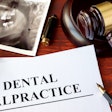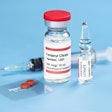
Would you practice differently if you didn't have to worry as much about getting sued? You would if you're like the average U.S. healthcare practitioner, according to the U.S. Congressional Budget Office (CBO).
In an October 9 report, the CBO estimated that limiting liability could save the U.S. $11 billion in healthcare expenditures a year, partly because doctors would do fewer unnecessary procedures. The report gives new impetus to malpractice liability reform being debated in the U.S. Congress.
At the same time, President Barack Obama has ordered the Department of Health and Human Services to spend $25 million funding demonstration programs exploring ways to reduce liability premiums and increase patient safety.
“It's very rare in dentistry that you get a verdict over $250,000.”
— San Francisco malpractice attorney
Edwin Zinman, D.D.S., J.D.
The ADA supported an unsuccessful amendment to the healthcare reform bill that passed October 13 in the Senate Finance Committee. The amendment, by Sen. Jon Kyl (R-AZ), would have set a cap of $250,000 on noneconomic damages in healthcare liability lawsuits.
"We are of the mind that medical liability adds to healthcare costs," said William Prentice, director of the ADA's Washington office. He said the organization is likely to back Kyl's further efforts to limit liability.
But he acknowledged that the legislation, so far championed mostly by Republicans, has an uncertain future in a Congress controlled by Democrats. And opponents and proponents agree that the effects on dentistry of the national legislation being considered would probably be minor.
For many doctors, liability insurance is one of the biggest costs of doing business. A survey by Medical Economics magazine found that family physicians, internists, and pediatricians paid a median of $12,500 a year in premiums for this coverage in 2007. That number had risen sharply from 1998 to 2004 before declining slightly in subsequent years. It's one reason that liability reform has picked up steam in recent years.
Dentists pay less
Dentists, by contrast, were paying $3,990 a year in 2005, according to the most recent ADA survey. The cost amounted to only 7% of the average dentist's expenses, and the number was staying fairly constant, the organization found.
"We've had extremely stable rates for 15 years," said Kathy Mudge, chief administrative officer for The Dentist's Insurance Company, which insures more than half of California's dentists against malpractice claims.
Mudge couldn't explain why dental liability premiums have changed less than medical ones. But it's not hard to see why dentists pay less to begin with. "Dentistry isn't really a life or death proposition, while medicine is," she said.
The average dental claim is between $30,000 and $50,000, a tenth the size of what physicians' insurers are paying out, according to a 2006 article in the Journal of the American Dental Association (Vol. 137, pp. 1444-1445).
So a cap of $250,000 on damages -- one of the most widely advocated types of liability reform -- would have little effect. "It's very rare in dentistry that you get a verdict over $250,000," said San Francisco malpractice attorney Edwin Zinman, D.D.S., J.D.
Even Prentice acknowledged that dentists would not see a big difference in their bottom lines as a result of such legislation. "Dentists are affected mostly as consumers," he said. "We've not had the severe costs that we've seen in the medical community."
Dr. Zinman argued that an already existing $250,000 cap on "pain and suffering" damages in California, which has stayed constant since 1975, should be raised. "Many states without caps have even higher premiums," he said.
Setting a cap doesn't serve justice, he said. "If someone is injured, they should be compensated. It's so unfair -- if a dentist hits a patient with her car, there is no limit. But if she does the same thing with a dental instrument, it's capped at $250,000."
Caps could also do more harm than good, he said. "If there were no safeguards whatsoever, you would increase the number of injured patients, so that would drive up the cost of healthcare."
Experts disagree on that point, according to the CBO report. It cited a 2009 study (Working Paper No. 15383, National Bureau of Economic Research) that found that a 10% reduction in medical liability costs would result in a 0.2% increase in overall mortality, and a 2002 study (Journal of Public Economics, Vol. 84:2, pp. 175-195) that found that a reduction in liability costs would have no effect on health.
Overall, the CBO found that liability reform would reduce spending on liability insurance premiums by $4.4 billion. And it would reduce utilization of healthcare by $6.6 billion. That's because doctors would order fewer tests and "just in case" treatments if they were not as afraid of being sued for making a mistake. Overall, the savings would reduce the nation's spending on healthcare by 0.5%, the CBO said.
That's significant, but it's much less than proponents have argued. Sen. John Cornyn (R-TX), citing the work of economists Daniel P. Kessler and Mark B. McClellan, has said that medical liability reform could reduce healthcare spending by between 4% and 9%.
No more deep pockets
And the savings wouldn't result purely from a cap on damages. The CBO based its estimates on a package of reforms. Also included would be a change in the "deep pocket" rules that allow plaintiffs to recover an entire award from any one of multiple defendants. Instead, a defendant's liability might be made proportional to that person's responsibility for the injury.
Other reforms would take into consideration payments that defendants got from other sources and set a statute of limitations for making claims.
A number of states have already experimented with these reforms, and that's what the researchers quoted by the CBO used in making their estimates.
In fact, states have tried so many alternatives already that some advocates for the legislation say there's no point in more pilot programs. Obama isn't just calling for tort reform, however; he wants to fund initiatives that would address the following goals:
- Put patient safety first and work to reduce preventable injuries.
- Foster better communication between doctors and their patients.
- Ensure that patients are compensated in a fair and timely manner for medical injuries, while also reducing the incidence of frivolous lawsuits.
- Reduce liability premiums.
Advocates of tort reform say they still want to see actual legislation passed, and sooner rather than later. "What the president proposed is a good first step," said Prentice. "But we would like to see something more substantial."
He predicted that the issue might resurface if congressional Democrats try to attract Republicans to support the healthcare reform bills now on the floors of both Houses.
Copyright © 2009 DrBicuspid.com



















